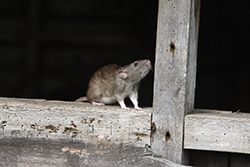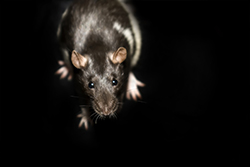Winter Rodent Pest Control Inspection Checklist: The National Pest Management Association (NPMA) recognizes November 16-22 as Rodent Awareness Week. Why devote an entire week to educating the public on rodent awareness? And why in late November?
Winter rodent pest control becomes an issue beginning in later November when rodents are likely to be seeking a warm place to ride out the Winter, and that warm place may be your home!
 Why Winter Rodent Pest Control?
Why Winter Rodent Pest Control?
Winter rodent pest control is important because rodents are carriers of a vast array of diseases, such as Salmonella, murine typhus, infectious jaundice, rat-bite fever and the potentially fatal Hantavirus. They can also chew through drywall, insulation, wood and electrical wiring, increasing the potential risk for fires.
 Your Winter Rodent Pest Control Checklist
Your Winter Rodent Pest Control Checklist
Check your home for these 5 signs of a possible rodent invasion:
- Droppings: A trail of rodent droppings is typically found in kitchen cabinets and pantries, along walls, on top of wall studs or beams, and in boxes, bags and old furniture.
- Noises: Rodents often make scurrying sounds, especially at night, as they move about and nest.
- Gnaw marks: New gnaw marks tend to be rough to the touch and are light colored.
- Burrows: Inside, rodents often nest in various materials such as insulation, and they are drawn to areas that are dark and secluded.
- Damaged food packages: House mice prefer to feed on cereals and seeds, while Norway rats prefer meat, fish and dry dog food. Credits: Hulett Environmental Services encourages public awareness of …
 Winter Rodent Pest Control Most Wanted List
Winter Rodent Pest Control Most Wanted List
House Mouse
House mice are gray or brown rodents with relatively large ears and small eyes. An adult weighs about 1/2 ounce and is about 5 1/2 to 7 1/2 inches long, including the 3 to 4 inch tail.
Although house mice usually feed on cereal grains, they will eat many kinds of food. They eat often, nibbling bits of food here and there. Mice have keen senses of taste, hearing, smell and touch. They are excellent climbers and can run up any rough vertical surface. They will run horizontally along wire cables or ropes and can jump up 13 inches from the floor onto a flat surface. They can slip through a crack that a pencil will fit into (sightly larger than 1/4 inch in diameter).
Your Winter rodent pest control most wanted list begins with the house mouse because in a single year, a female may have five to 10 litters of usually five or six young each. Young are born 19 to 21 days after mating, and they are mature in six to 10 weeks. The life span of a mouse is about nine to 12 months. This breeding activity can continue throughout the Winter.
Norway rats are husky, brownish rodents that weigh about 11 ounces. They are about 13 to 18 inches long including the 6 to 8 1/2 inch tail. Their fur is coarse and mostly brown with scattered black on the upper surfaces. The underside is typically grey to yellowish-white.
Rats will eat nearly any type of food, but they prefer high-quality foods such as meat and fresh grain. Rats require 1/2 to 1 fluid ounce of water daily when feeding on dry food. Rats have keen taste, hearing and sense of smell. They will climb to find food or shelter, and they can gain entrance to a building through any opening larger than 1/2 inch across.
Your Winter rodent pest control most wanted list contains rats because, like the house mouse, they are active breeders. Rats have litters of 6 to 12 young, which are born 21 to 23 days after mating. Young rats reach reproductive maturity in about three months. Breeding is most active in spring and fall, and the more abundant the Winter food source, the more energy they have to breed. The average female has four to six litters per year. Rats can live for up to 18 months, but most die before they are one year old.
Our Winter rodent pest control list has a final character, the vole. Most people go their whole lives without ever so much as hearing about voles, let alone controlling them. Voles are sometimes referred to as “meadow mice” or “field mice.” They construct well-defined, visible tunnels, or “runways” at or near the surface, about two inches wide. Vole runways result from the voles eating the grass blades, as well as from the constant traffic of numerous little feet beating over the same path. And if any lawn and garden pest can literally “beat a path” through the grass due to their sheer numbers, it’s the voles. Rabbits don’t have anything over this prolific rodent! They can cause a lot of damage to your landscape. Credits: Mice, Rats and Voles – Omaha Pest Control, Inc
Why not celebrate Rodent Awareness Week this year by initiating a Winter rodent pest control program.
Call ApolloX Pest Control
(888) 499-7378

















Recent Comments